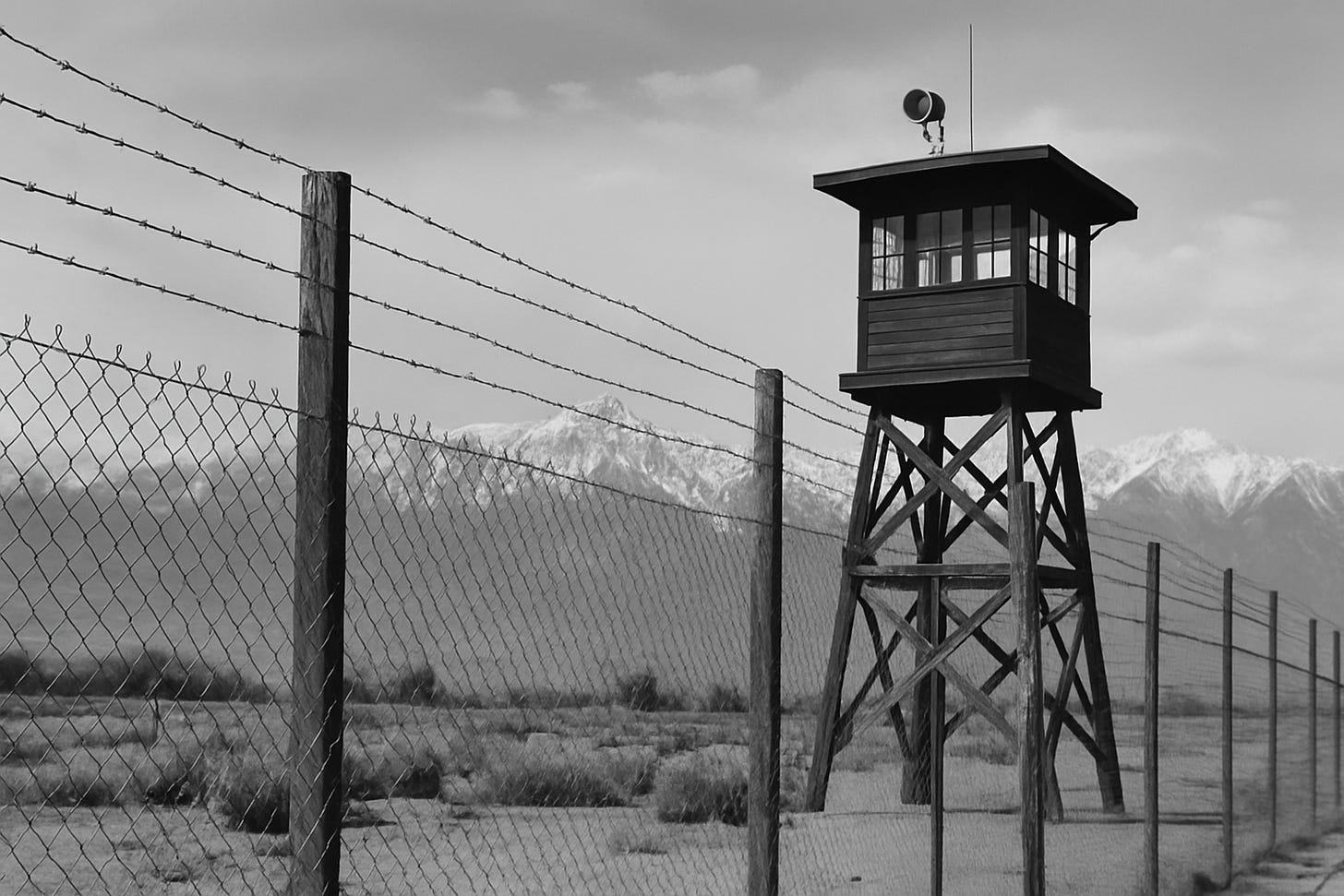42. A Loaded Weapon
Race, war, and the Constitution in Korematsu
It’s easy to talk about constitutional rights when things are calm. But what happens in moments of crisis, when fear is high and the stakes feel existential? That’s the test. And in 1944, the Supreme Court failed it.
Korematsu v. United States is one of the most infamous decisions in the Court’s history. It upheld the forced removal and incarceration of Japanese Americans during World War II—a policy that was openly based on race.
After Japan attacked Pearl Harbor in 1941, fear swept across the U.S., especially along the West Coast. In response, President Roosevelt signed Executive Order 9066, which authorized the military to exclude people from designated zones. In practice, this meant rounding up more than 120,000 people of Japanese ancestry (most of them U.S. citizens) and sending them to internment camps. No trials. No evidence of wrongdoing. Just ancestry.
Fred Korematsu, a young American-born citizen, refused to comply. He was arrested and convicted for defying the exclusion order. He challenged that conviction all the way to the Supreme Court.
The legal question was clear: Could the government forcibly relocate citizens based on race and still stay within the bounds of the Constitution?
The Court’s answer by a 6–3 vote was yes.
Writing for the majority, Justice Hugo Black acknowledged that racial classifications are “immediately suspect.” But he accepted the government’s argument that the exclusion order was a necessary security measure in wartime. He said this wasn’t about racial prejudice, but military judgment. The government didn’t have to prove that every Japanese American posed a threat, only that the threat was plausible.
But not everyone on the Court agreed. Justice Murphy called it “legalized racism.” Justice Jackson warned that the decision created a “loaded weapon” for future governments to use racial discrimination whenever fear took hold.
Justice Frankfurter, who concurred in the judgment, stood apart in a different way. He didn’t pretend the policy wasn’t racist. He didn’t rely on military expertise. Instead, he argued that the Constitution itself permitted it. The president and Congress, he said, had the authority to act in wartime, even if that meant racial classifications.
This was more than deference to the executive. It was a constitutional theory: that emergencies change the legal landscape, and that the judiciary has no business second-guessing war powers.
The Court’s decision in Korematsu was based on national security. But history has shown how flimsy those justifications were. Years later, we learned that the government had actively suppressed evidence contradicting its claims of Japanese American disloyalty.
The camps weren’t humane. Families lived in tarpaper barracks behind barbed wire. Their businesses were gone. Their lives uprooted. And it was all done with the blessing of the highest court in the land.
It wasn’t until 2018—more than 70 years later—that the Supreme Court finally said aloud what had long been obvious: Korematsu was “gravely wrong the day it was decided.”
But even as the Court disavowed Korematsu, it upheld a different policy—President Trump’s travel ban, which disproportionately affected Muslims—under the same logic of deference to national security.
So the question remains: How do we tell the difference between security and scapegoating? And what role should courts play in times of fear?
Korematsu isn’t just a case about the past. It’s a warning about the future.



It’s impossible to reflect on this post without bringing up the South Florida Detention Facility (otherwise known as Alligator Alcatraz), as well as the Trump Administration’s goal of reopening Fort Bliss, a former internment camp of Japanese Americans, as well as every individual who has been racially targeted by the Trump Administration and unlawfully been taken into custody of the U.S. Government. With regard to the first question, telling the difference between security and scapegoating, on some fundamental level, comes down to both individual responsibility for seeking out the truth and an uncorrupted education in history (which arguably is probably becoming more difficult to obtain). Because national security is (literally) a constant excuse so violently steeped in policy, it’s difficult to answer the question posed regarding what role courts should play in times of fear. Frankly, I find it difficult to conceive of a time in U.S. history where fear does not exist as it pertains to the scapegoating of racial/ethnic minorities. What can be said for certain is that the courts have reflected and ruled far too late in the timeline of these camps (and bans) for it to be of any legitimate use beyond the belated and ineffectual reckoning with the state-sanctioned violence that occurs. What is clear in the 9 months after Trump took office is the importance of the very courageous federal district court judges who have been able to take meaningful action (such as the judges blocking Kilmar Abrego Garcia’s deportation the first and now second time). In times of fear, those judges have been effectual safeguards in a way SCOTUS has proven unwilling. While an unsatisfying and incomplete answer, it seems that some of our most effective tools in the present moment are those judges closest to us, and perhaps we've underestimated the importance of those first stopgaps.